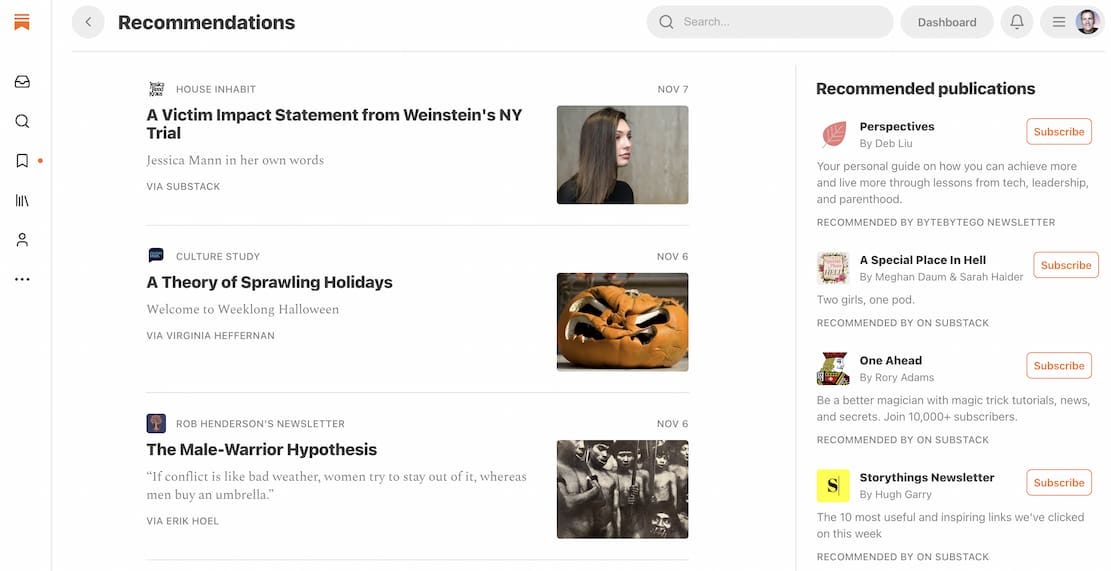The case for replacing Twitter with Substack
Substack will never be Twitter. But for journalists, readers, politicians and intellectuals, Substack is surprisingly well positioned as the best place to go for Twitter quitters.
Twitter is burning. Longtime users blame arsonist Elon Musk for buying the network against everybody’s wishes, then creating chaos and uncertainty out of nothing.
The crisis is driven by fear of what’s to come, based on Musk’s mass, chaotic layoffs, plus his plan to end verification and replace it with a priority-for-money scheme merely called “verification.” It’s also based on Musk’s comments that he’ll take a more extreme approach to “free speech,” possibly allowing banned haters and former presidents back on the site. Musk is even considering putting all of Twitter behind a paywall.
In a world in which Facebook is a train-wreck, Google+ is long dead and TikTok and Instagram are too video and picture focused for word-obsessed Twitter nerds, where do you go?
Two main contenders have stepped forward. The first is Mastodon. And the second is Substack.
Unlike Substack, Mastodon is a social network exclusively. But I just don’t see Mastodon ever taking off. Mastodon is called by some the “Linux of social networks,” which is apt. It offers both the moral superiority of being an open, ad-free distributed network combined with the ugliness and user unfriendliness that made Linux fail as a mainstream user operating system.
More technical users are fine with Mastodon. But the most active Twitter users — journalists, politicians, writers and others — will never embrace Mastodon. Yet many are already on Substack.
Ten percent of Twitter users post 80% of the tweets. These super active users, called the “twitterati,” are Twitter’s beating heart. And it’s these most active users that might find Substack far more palatable than Mastodon.
Today, the main energy behind advocating Substack as a Twitter replacement is…. Substack. Self-serving, to be sure. But they do have a point. Here’s what most of the “twitterati” use Twitter for:
News, including breaking news
Opinion, through links and hot-take tweets
Conversation with smart people
There’s news on Substack — including great, original reporting — but it’s not the kind of broad news feed that Twitter offers. But breaking news tools, including RSS readers like Sumi News and websites like Brutalist Report, are a dime a dozen.
That leaves opinion and conversations. Substack is one of the best places on the internet to find the most informed, best-reported opinion pieces (if I do say so myself). A huge percentage of some of our most interesting thinkers publish Substack newsletters, with more joining every day.
Why Substack is actually a social network
Substack’s discovery engine is fantastic. It constantly recommends pieces, as well as publications, every day on its recommendations page.
As with Twitter, the Substack Inbox alerts you instantly when someone you’re following (sorry, “subscribed to”) posts something. And from there you can read, like, comment and so on.
And that’s where the conversations with smart people come in. Once you comment, you enter into a threaded conversation with other readers and with the author. Just like on Twitter. Notifications alert you about Comments as well, so you don’t miss anything.
The newest conversational tool is Substack’s Chat feature, which they rolled out this week. Chat is where you can post what are essentially tweets, and people who subscribe to you see them in the app, and can reply.
Just to clarify, Comments are conversations attached to a published article and you can engage with them both in the Substack app and on the web; Chats are conversations between a writer and their subscribers and are not attached to a published article, nor are they available on the web version — Chat is app-only.
The combination of following, comments and chat turn Substack into a social network, albeit one with fewer people, but with less noise, heat and trolling (and a lot more intellectual stimulation and learning).
I hope Twitter survive’s Musk’s midlife crisis. But if it doesn’t — if Musk kills Twitter — you’ll still find me here on Substack.
Mike’s List of Brilliantly Bad Ideas
1. New headset actually kills you if your game character dies
Oculus VR founder and designer of the Oculus Rift, Palmer Luckey, revealed his latest project: A virtual reality headset that kills you if your VR avatar dies in the game. It also kills you if you remove it from your face. The headset, which Luckey says is a kind of “art project,” contains explosives, which are triggered with a photosensor. When game developers build in support, their games will flash red when the avatar dies, triggering the bomb and blowing your head off. The beta program has zero users.
2. LG created a display that stretches like Silly Putty
LG Display has unveiled the world’s most stretchable display. It can be stretched by up to 20% of its original size without damage. It can also be folded and twisted. The stretchiness is made possible by a special film substrate made from the same silicon that enables flexible contact lenses. (Samsung debuted a flexible OLED display technology five years ago, but LG’s is way stretchier.) LG says the technology enables displays attached to clothing, cars — even skin (although I think that’s a stretch).
3. A bar made for a car — what could go wrong?
Some UK knuckleheads are kickstarting their “Car Bar” — a bar that installs on the back of a car seat so that everyone can make drinks without spillage. And while the product could be used for non-alcoholic beverages, the company’s web site explicitly markets it for beer, wine and distilled alcoholic drinks. Uh… Needless to say, open container laws make this illegal for use with alcoholic beverages. Go home, entrepreneurs. You’re drunk.
4. Startup wants to make stalking more social
It’s well known that many unsecured or deliberately public IP cameras around the world offer countless hours of perfect boredom. They tend to show people milling about, unaware that some creepy rando on the internet somewhere is watching them. Now, a startup called Watchatapp wants to turn those cameras into a social network. The Kickstarter envisions that many of the people on the video will be Watchatapp members, and that they’ll be matched by their GPS location — not by facial recognition — in real-time, enabling watchers to click on the person and send them a “friend request.” Obviously and thankfully this product can’t work and will never exist.
Mike’s List of Shameless Self Promotions
How ‘synthetic media’ will transform business forever
Bashing 4 new myths about digital nomads
Why are cloud misconfigurations still a major issue?
Smartphone satellite expectations will soon crash to Earth
Digital nomad pro tip: Don't skimp on a backpack!










Hhmm. I created my Substack account a while ago and never came back until getting your post in my e-mail.
I'm not sure if I will be a Twitter Quitter (ha ha, love that term) but I will be taking another look at Substack.
I also agree that Mastodon is not for everybody. It might have spiked with new users for now but I doubt they will stay for the long run. It is fair to say that it's the Linux of social plataforms, being miles away from what Twitter can currently do.
I will be waiting out the Twitter chaoes that is going on now and see what happens; yet, I am open to explore what else is out there.
What I want from a "social media feed":
* Most posts consist of blurb, screenshot, and link to the "full content"
* Show me only feeds I've subscribed to, unless I explicitly enter some view to explore the wider world.
* easy to perma-block anyone who's clearly going to annoy me without being afraid they'll consider me having disowned them from the family (the Facebook problem).
* comments system where each account is given full control to moderate/block as they see fit.
In this way, twitter was oddly perfect. Short posts, links, and a screenshot have been the status quo. It's been really useful in our local community for sharing county announcements and emergency information, but also the critical item is that almost all useful posts on twitter LINK TO ANOTHER SITE WITH FULL CONTENT.
The ideal network to me is a fancified RSS feed with screenshots, subscriptions controls, and lots of moderation controls. Aka, Twitter.
So far I don't see substack replacing that at all. More like Substack ends up being one of the popular sites that's being linked to FROM a site like twitter. So far, overall, discoverability in substack is slow and painful. It lacks an "attract mode" (gaming industry term). But also, adding one will necessarily alienate existing users who like a comparatively quiet slow-paced social circle that exists here currently.
I think life is better if the content sites and the RSS feeds that make them discoverable remain separate. What we need is a new RSS feed to replace Twitter, and ideally one not named Truth Social.